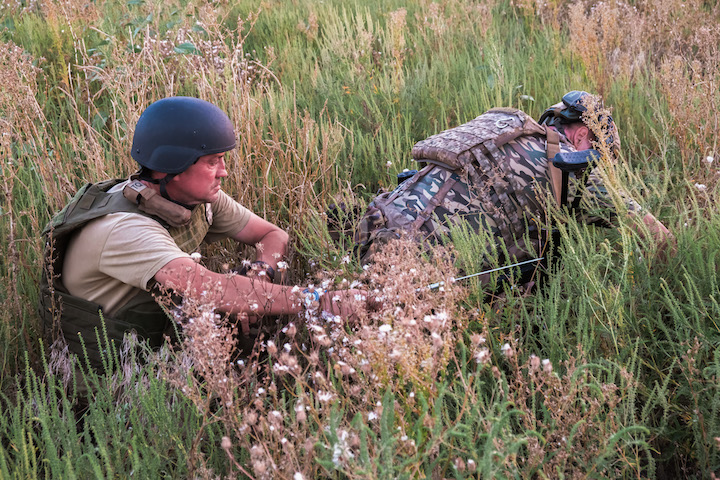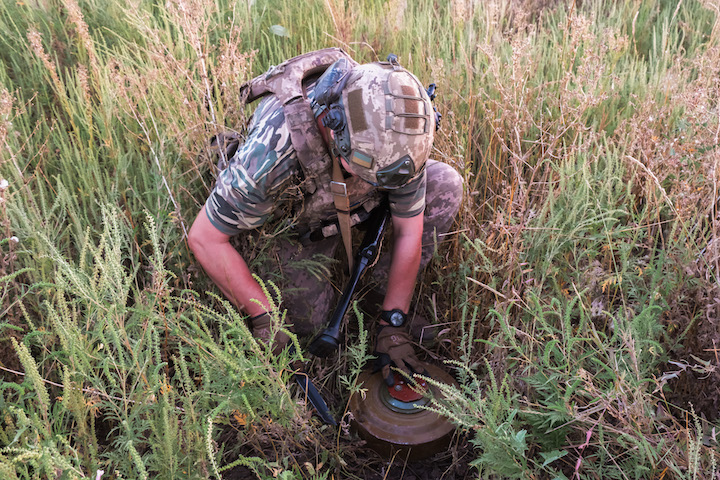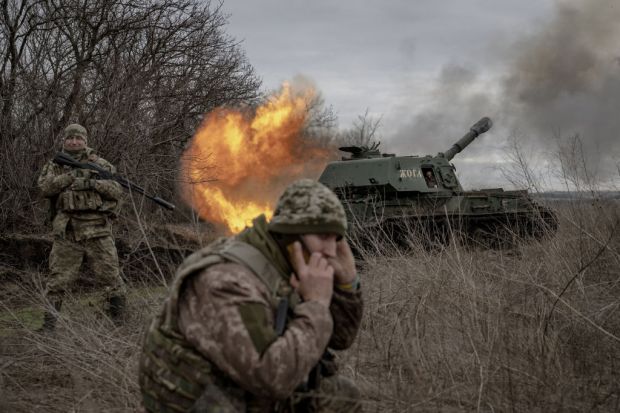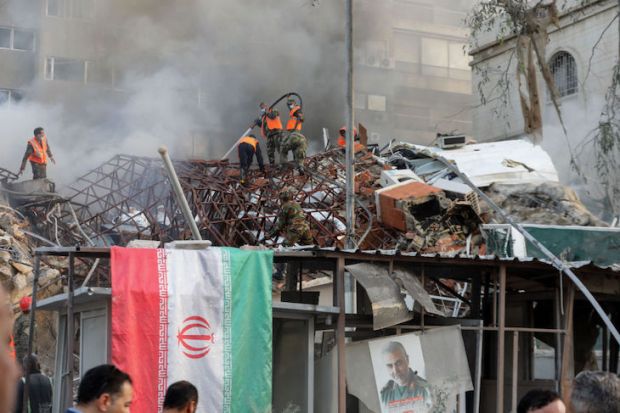Nearly three months into their counteroffensive, the Ukrainian army has finally found a way to breach the first line of Russian defence. Ukraine has moved through minefields, ‘dragon’s teeth’ defences and swarms of drones. They have retaken the village of Robotyne which lies on the highway to Tokmak, the next objective on the way to Melitopol (one of the main Ukrainian targets for blocking the land corridor to Crimea). Russia is trying to reinforce its defences, while Kyiv is anticipating a much-needed breakthrough.
Russian forces have built some of the most extensive battlefield fortifications seen in Europe since the second world war to defend those borders it has managed to establish. To date, approximately 1,500 mines have been planted per square kilometre in the south of Ukraine. The Ukrainian army now has to face a layered Russian defence north of the village of Novoprokopivka, one that is manned by Russian reserves, an extensive artillery, and the same mine density as on the path to Robotyne.
In June, Russian mines destroyed many Western vehicles and caused massive casualties amongst Ukrainian personnel. Ukraine is the most heavily mined country in the world with a third of its land now deadly to walk on. It is mainly for this reason that it took the Ukrainian army ten weeks to overcome the first line of Russia’s defence and capture the first village on the road to Tokmak.
Kyiv’s strategy has improved since then. Now, the path for the Ukrainian infantry is cleared by combat engineers, or ‘sappers’ – only then do heavy armoured vehicles follow. Armed with metal detectors and mine-clearing kits, sappers hunt for mines under heavy Russian fire. ‘We go ahead of the infantry, ahead of the intelligence – we go ahead of everyone’, says Varan, sapper platoon commander for the 108th brigade.
Varan commands a ten-member sapper team searching for possible routes for troops through the grey zone between the Ukrainian and Russian sides. He says the parameters of the grey zone change constantly as both armies install new mines and unexploded shells scatter the terrain.
Sappers work in bulletproof vests, but without heavyweight suits. ‘It would severely hamper your mobility,’ says Varan. ‘In a combat situation, we can be either mobile or heavily-armoured. We can’t be both.’ In the open fields and steppe of the Zaporizhzhia region, the likes of Varan are easily exposed to enemy. So they often crawl, supervised by drones or covered by artillery fire, wearing light body armour, helmets and knee pads as they approach the areas they are demining. Bad weather plays into their hands, as it makes life harder for Russian spy drones.
The Kremlin’s strategy in the field has been to create a buffer zone ahead of their front line with so many explosives that the ground becomes virtually unpassable for ground troops. A sapper needs about 15 minutes to remove one mine. In heavily mined areas it can take them up to four hours to clear about 100 meters. They are in it for the long haul if Ukraine needs to cover 18 miles just on the route to Tokmak.
The sappers do have some tools for detecting mines at their disposal, such as minesweepers, mine probes and even aerial reconnaissance. Some mines heat up from the sun during the day and emit a glow visible on thermal imagers at night, making it easing to spot them. This advantage will disappear with the onset of cold weather, and even now it doesn’t always help. ‘It works only for mines with a metal case. The ones with plastic or that are buried in the ground don’t heat up, so we have to walk and find them visually,’ Varan tells me.
 Sappers from the 108th brigade at work (Credit: Svitlana Morenets)
Sappers from the 108th brigade at work (Credit: Svitlana Morenets)
Then there is the mine-clearing line charge: a small rocket carrying a rope of explosives. Fired about 400 metres ahead of the sappers, the idea is that the explosives attached to the rope will all detonate, clearing the mines and leaving a safe passage wide enough for troops and vehicles. Additionally, anti-mine trawls installed on vehicles decrease the chances of explosives detonating under military equipment and personnel when convoys are on the move. Shelling Russian positions with artillery also helps detonate part of the explosives.
The goal of the demining team is to clear a narrow path so the infantry and vehicles can advance. Then, on their way back, sappers broaden the trail further, using minesweepers and mine probes.
This work is made harder due to the fact that soldiers are encountering the kind of anti-personnel landmines banned by international law. Recently, a gruesome video circulated of a Ukrainian soldier who jumped from a truck and was instantly blown up. He survived but lost a leg. ‘It was a forbidden anti-personnel high-explosive mine’, Varan says. ‘Its hard to spot. It has very few metal objects inside, so the minesweeper may not react to it. You also can’t poke the ground with a metal stick to check every centimetre of land while Russians fire at you,’ he explains. So even when sappers clear a path, there is still a chance of stepping on something and being blown up.
Russians have widely been launching prohibited ammunition, in particular phosphorus bombs. ‘If there is heavy shelling, you lie down and crawl before the mine probe’, Volodymyr, a sapper of the 108th brigade, tells me. ‘The Russians are employing similar tactics, donning suits that block heat to evade detection by thermal imagers as they advance towards us.’
Even when sappers clear a path, there is still a chance of stepping on something and being blown up
He says that before the start of the counteroffensive, the war in the Zaporizhzhia region was fought by sabotage-reconnaissance groups on both sides. ‘Neither side had the strength to seize the land, to break through. So they crawled with a sapper ahead of them and had small fights in enemy trenches before coming back. Even if you won, you could not keep that position – you must take several others and cover all approaches to secure the liberated area.’
While the Ukrainian army is making advances, recaptured territory is still filled with mines and self-made explosives. Often ‘surprises’ that have been left behind are torn apart during shelling or a fire that started due to shelling – burning bushes and trees can trigger the mines. All of this increases casualties.
This also doesn’t discount the potential for a breakthrough in the opposite direction: Ukrainian sappers must deploy mines to impede Russian forces. ‘It is very heavy. One mine weighs about 10 kilograms, you must run with at least four on you, plus equipment, then quickly install everything and run back,’ Vitaliy, another sapper of the 108th brigade, explains. He adds that several hundred mines are needed to cover five to six kilometres of land. Following the war, these mines shouldn’t pose an issue, as the locations where they have been planted have all been noted down; there are significant doubts that the Russians are doing the same.
Over the weekend, Volodymyr Zelensky said that once the Ukrainian army reaches the administrative border with occupied Crimea, there could be the opportunity to politically pressure Russia into returning it with ‘fewer casualties’. Earlier, he said he was not sure Kyiv could talk about the military de-occupation of Crimea in public at the moment. This softened diplomacy might help Ukraine in maintaining Western support, especially if the impending autumn mud and winter cold hamper the Ukrainian army’s progress. Nevertheless, the possibility remains for Ukrainian forces to shift the momentum of the fight – as the last week has shown, chances for a big breakthrough are still high.
Got something to add? Join the discussion and comment below.
Get 10 issues for just $10
Subscribe to The Spectator Australia today for the next 10 magazine issues, plus full online access, for just $10.




















Comments
Don't miss out
Join the conversation with other Spectator Australia readers. Subscribe to leave a comment.
SUBSCRIBEAlready a subscriber? Log in